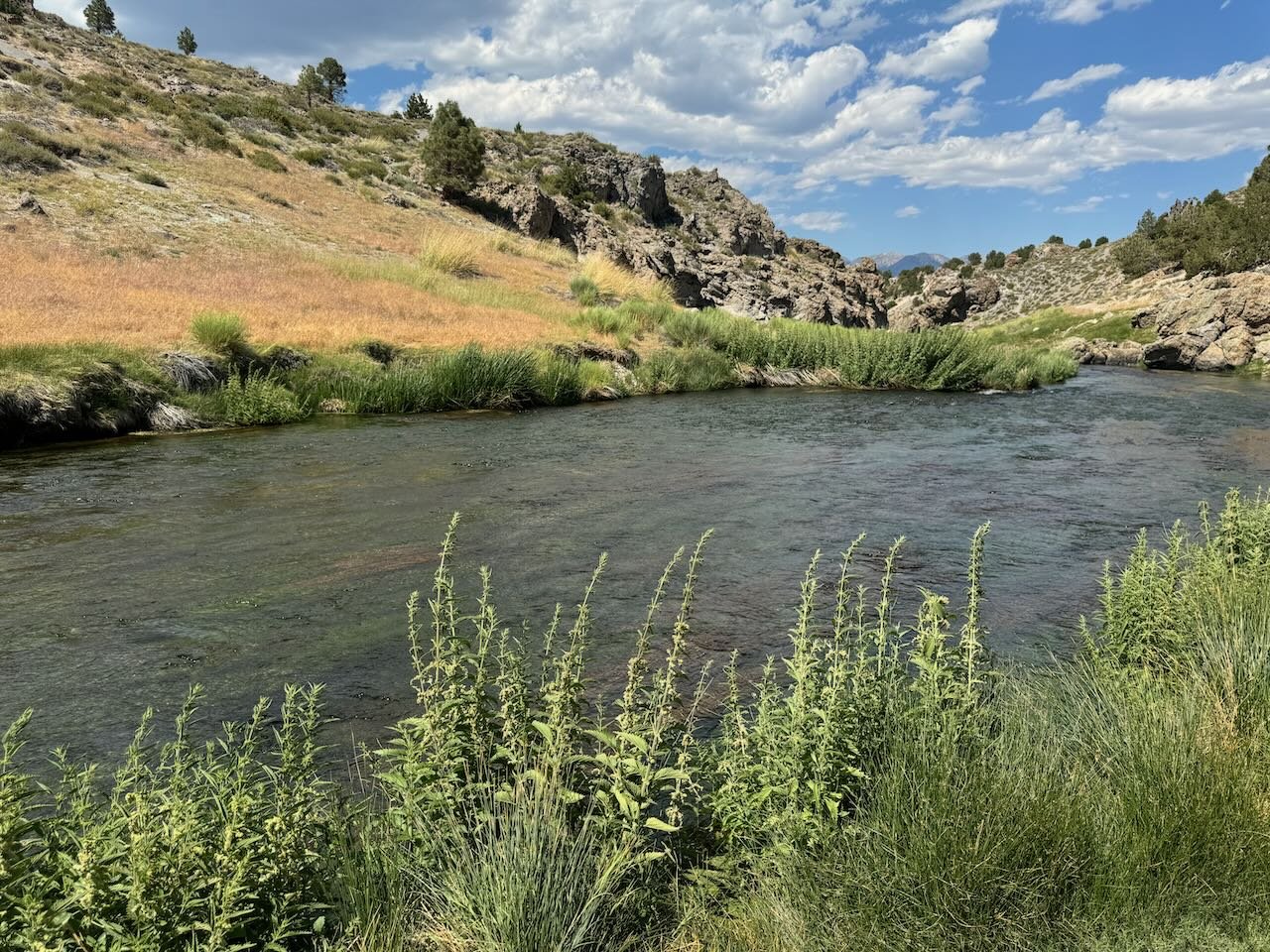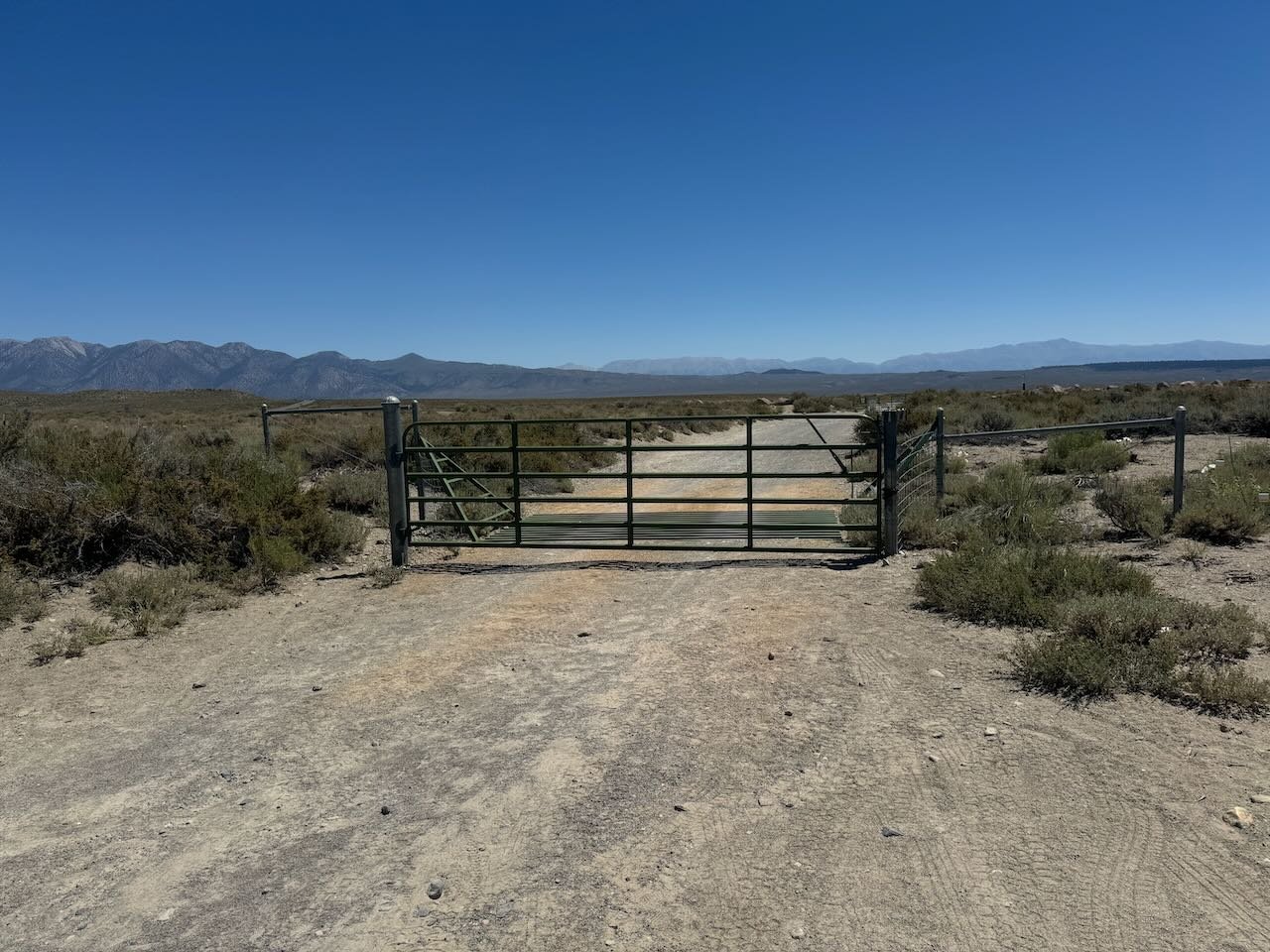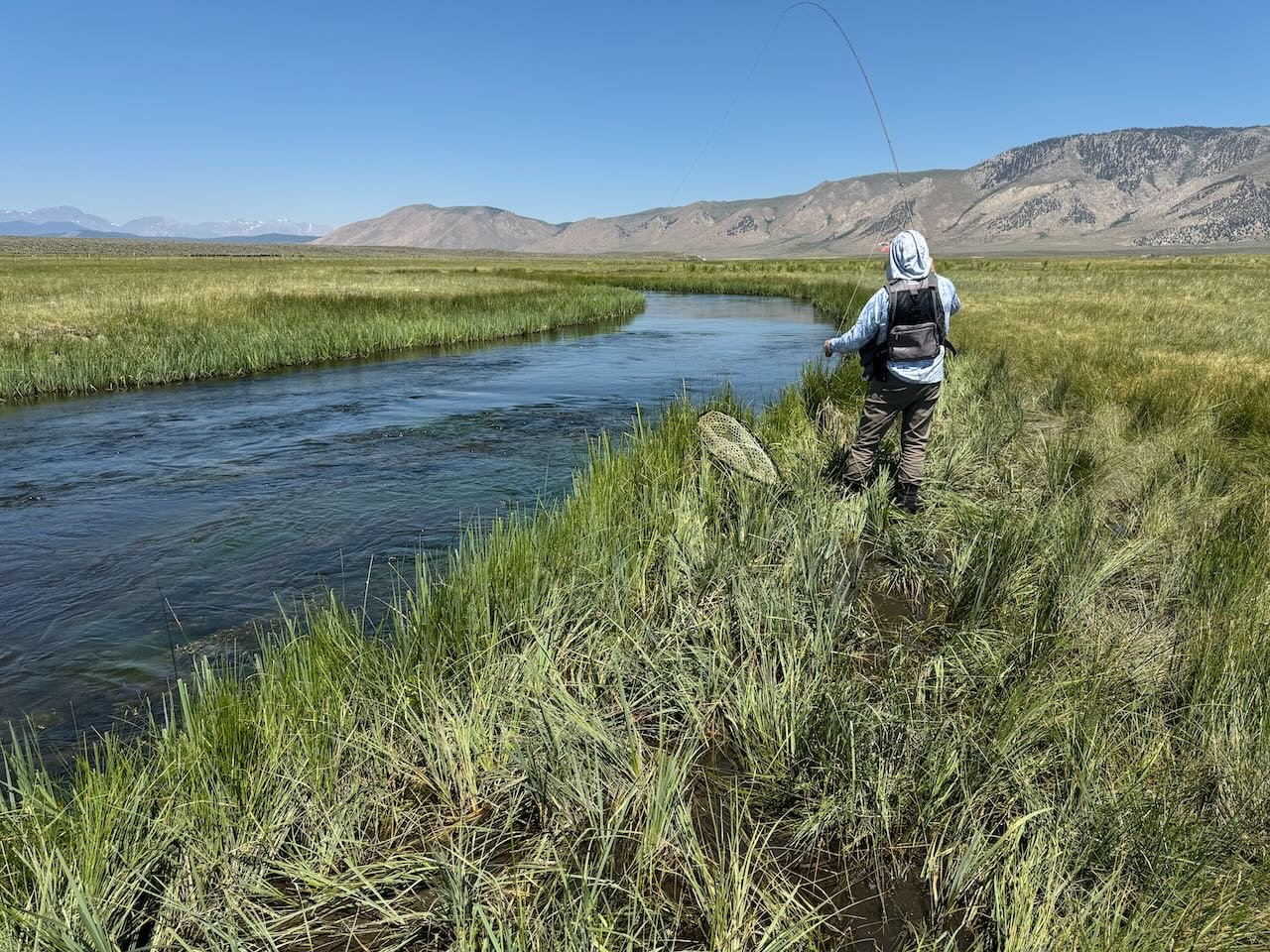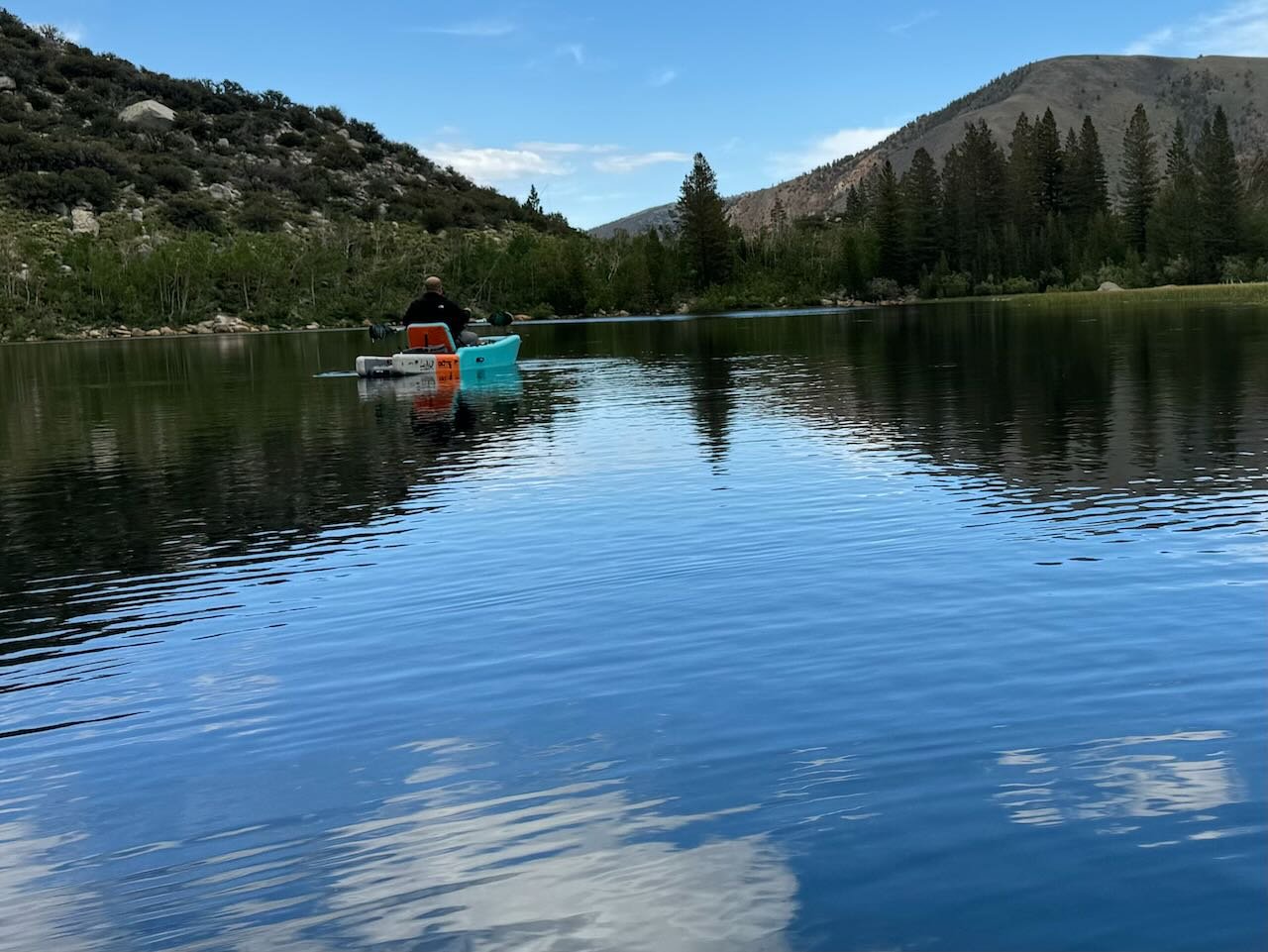There is a heat wave in the Eastern Sierra. Air temperatures in the Long Valley area have been in the low 90’s. It got up to 109 in the Owens Valley this week. Keep cool out there and be sure to drink lots of water. It’s time to be aware of water temperatures on the waters you fly fish. I’ve been tracking the temperatures of the rivers I fly fish and the water temperatures are staying cool enough to fly fish all day. Water temperatures at 70 degrees and higher is when fly fishers should voluntarily quit fly fishing because of the increased mortality rates to trout. Early morning and late evening water temperatures are normally low enough to allow fly fishers to safely practice catch and release fly fishing. Not seeing a lot of hoppers on Eastern Sierra waters right now. We do not get big numbers of hatching stoneflies in the Eastern Sierra, but right now is the time to fish the little yellow stone fly hatch. Caddis, midges (in the still waters) and mayflies are hatching and the trout are feeding on them. Nymphing and dry fly fishing is producing trout in Eastern Sierra waters.
Lupin flowering in the Eastern Sierra is a sign of summer while driving to the waters fly fishers fish.
East Walker River
Below Bridgeport:
Nymphing and dry fly fishing is producing fish in the East Walker River. Middle of the day heat is slowing the bite. Water flows are perfect for wading the river to present the flies to the trout. Caddis, mayflies and stoneflies are the hatches that are producing the trout. Nymphing under an indicator or with a Euro rig with size 18 olive quilldigons, size 18 bead head flash back pheasant tail nymphs, size 16 bead head flash back gold ribbed hare’s ears, size 12 stoner nymphs, size 12 green/gold wire Prince nymphs and size 16 rust La Fontaine’s sparkle nymphs. Size 16 Adams parachutes, size 16 elk hair caddis, size 16 X-caddis and size 16 Lawson’s little yellow stone fly are the dry fly patterns the trout are taking of the surface of the East Walker River.
A little yellow stone fly that hatched on the East Walker River.
Hot Creek
Interpretive Site:
Consistent hatches of mayflies, caddis and stoneflies have the trout feeding on the surface from early morning to early afternoon. Fishing with size 16 Adams parachute, size 20 blue wing olive parachutes, size 16 pale morning dun (PMD) parachutes, size 16 PMD sparkle duns, size 22 olive female trico dun parachutes, size 20 gray elk hair caddis, size 20 gray parachute caddis and size 20 X-caddis in gray are the dry flies that will imitate the hatching insects of Hot Creek. Fly fishers should be on the water by 8:30 for the trico hatch and the day is over by 2:00 P.M. when the pale morning duns are done hatching.
The weed beds in the creek and the stinging nettles on the bank are hazards fly fishers need to avoid to successfully fly fish Hot Creek in the Canyon.
Hot Creek
Canyon Section:
Fly fishing in the canyon is fun if you know how to work your flies around the weed beds that are at full growth in the creek. The tiny slots between the weeds is where fly fishers need to drift their nymphs and dries. Drifting a dry fly in these narrow slots is much easier than drifting a nymph. During the hatch the trout are easy to find as they give up their location when they rise to the surface to feed on the adult hatching insects. Nymphing with size 18 bead head flash back pheasant tail nymphs, size 18 olive quilldigons, size 12 stoner nymphs, and size 20 gray La Fontaine’s sparkle nymphs are producing trout if you can keep the nymphs from snagging on the weeds. Dry fly fishing with size 16 pale morning dun (PMD) parachutes, size 16 PMD sparkle duns size, 16 Adams parachute, size 20 blue wing olive parachutes, size 22 olive female trico dun parachutes, size 20 gray elk hair caddis, size 20 gray parachute caddis and size 20 gray X-caddis are fooling the surface feeding trout when the fly fisher can get a drag free drift.
The North Landing Road continues to be closed keeping fly fishers without a boat from accessing the north side of McGee Bay and the Owens River arm of Crowley Lake.
Crowley Lake
North Landing:
The North Landing Road continues to be closed. No word on when it will open. Lake levels continue to be high and the North Landing Roads around the lake are flooded in places. McGee Creek inlet continues to produce lots of fish for the boating flotilla working the flats in this area with midges, callibaetis nymphs and damsel fly nymphs. Gray midges, tiger midges, zebra midges, blood midges and albino Barron’s suspended from three inches to three feet of the mud bottom is producing 16 to 22 inch hatchery rainbows, browns and cutthroats. Stripping size 10 marabou damsel nymphs, a size 10 olive wooly buggers, a size 14 callibaetis nymphs and a size 14 olive gold ribbed hare’s ear is producing trout when stripped around the weed beds.
Hooked up on a juvenile rainbow trout that took a size 18 bead head flash back pheasant tail nymph fished under an indicator on the upper Owens River.
Upper Owens River
Above Benton Crossing Bridge:
The Fourth of July crowds are gone and the upper Owens River continues to produce juvenile and adult trout from three inches to 14 inches. The trout are feeding on size 16 elk hair caddis, size 16 pale morning dun parachutes, size 22 female dun trico parachutes and size 18 blue wing olive parachutes. Nymphing with size 18 bead head flash back pheasant tail nymphs, size 16 bead head flash back gold ribbed hare’s ears, size 18 olive quilldigons, size 16 hot spot pheasant tail nymphs, size 16 rust La Fontaine’s sparkle nymphs and size 16 peacock soft hackles has been consistently producing rainbows from three inches to 16 inches.
The slower pools on Rock Creek is where fly fishers should float their dry and dropper rig.
Rock Creek
Iris Meadows Campground:
The creek continues to flow high and cold. The trout are looking for food. Fly fishing in the slow water pools and runs is where fly fishers can catch trout with a dry and dropper rig. The best dry fly to fish with is the one you have the most confidence in. I like to use size 16 Adams parachutes, size 16 elk hair caddis and size 16 royal Wulff’s because their very visible on the water. Any nymphs will work but I use size 16 bead head flash back gold ribbed hare’s ears and size 18 bead head flash back pheasant tail nymphs.
Trolling a size 12 olive wooly bugger behind a float tube, kayak or raft produces lots of hits from wild brown trout and stocked rainbow trout.
Bishop Creek Canyon
North Lake:
Mosquitoes are out in full force particularly when fishing from the flooded shore line at the inlet into North Lake. This is a great spot to fish with a dry and dropper. For the dry fly fish with a size 14 olive stimulator, size 16 Adams parachute and a size 14 elk hair caddis. For the nymphs use size 18 or 20 tiger midge, zebra midge, size 18 bead head flash back pheasant tail nymph or size 16 bead head flash back gold ribbed hare’s ear. There are olive damsel nymphs and olive scuds in the lake. Stripping a size 12 olive wooly bugger on a dry fly line or trolling the wooly bugger behind a float tube on a full sink line will produce trout. The stocked rainbows love to grab the wooly bugger.
Finding the slower pools on the middle fork of Bishop Creek is where you will find trout willing to take your flies.
Middle Fork Bishop Creek:
Working up the creek looking for the spots where you can find the trout hanging out in the slower pools and runs and casting an Adams parachute with a bead head flash back gold ribbed hare’s ear on three feet of fluorocarbon tippet will produce wild brown trout and rainbow trout. Key to success right now is covering lots of water looking for those spots where the fish can see your flies drift by them. The water is still high and cold. The trout are looking for any insect that floats by them to eat.
Bishop Creek Canal is flowing at summer high levels and fly fishers will do the best to fly fish in the evening when the caddis are on the water laying their eggs.
Bishop Creek Canal
Behind Bishop Veterinary Hospital:
Temperatures in the Owens Valley this week reach 109 for a day or two. That’s way too hot to be out fly fishing during the day. Fly fishing in the evening when the caddis are on the water laying eggs is a great way to end a day in the Owens Valley. I like to cast my olive or peacock bodied size 16 elk hair caddis upstream and let it dead drift down the canal. When it gets to the bottom of the dead drift it will drag across the canal. Be ready to set the hook on the drag as that is where the fish will hit the fly. Across the middle of the canal I rarely get hit. When the caddis swings into the bank below me I get a lot of hits. I stirp in the caddis up stream. If the wind picks up the fly and smacks it against the water give some slack line to let the caddis pattern float downstream. If you don’t get hit pull the caddis upstream until its right in front of you on the water. Pick up the line and cast upstream repeating the previous drift.









